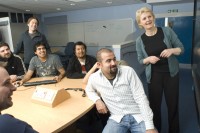
If you are interested in applying for the MSc in High Performance Computing at the School of Physics & Astronomy, the Open Days are a good opportunity to:
• Talk to staff from the MSc in HPC
• Discuss career opportunities and financial support
• Meet current students.
Upcoming MSc in HPC Virtual Open Days
Thursday 28th April, 12:00-13:00 BST
Thursday 5th May, 13:00-14:00 BST
Live sessions in the chat rooms and virtual space will allow you to talk to staff and current students about applying for the MSc, studying in the University, living in Edinburgh and any other aspect of studying with us.
Registration
To book your place, please send an email with your name and the session you would like to attend to msc [at] epcc.ed.ac.uk (subject: MSc%20in%20HPC%20Virtual%20Open%20Day)
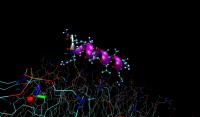
The School's Institute for Condensed Matter & Complex Systems and Oxford University have received £477,000 from EPSRC to study the molecular structure and function of novel protein fragments (peptides) designed to have potent anti-microbial activity. The work is an international collaboration and involes the UK's National Physical Laboratory (NPL) as an industrial co-funder and IBM Research in New York. Jason Crain will be the Edinburgh project leader.
The project seeks to understand how short protein fragments are effective in combating infection from bacteria and viruses and to reveal the molecular mechanisms by which they function. The aim is to design new and more effective molecules in collaboration with industrial partners.
The project combines synthesis of new materials with state-of-the-art experiment and computer simulations implemented on the Blue Gene supercomputers at IBM's Watson Research Labs and on facilities at EPCC. A particular aim is to understand the interactions of antimicrobial peptides with cellular membranes.
The work is relevant to the issue of antimicrobial resistance, which is recognised as a growing global concern with wide-ranging ramifications to the extent that the problem has been selected by the WHO as the theme for World Health Day 2011.
The project is part of a major collaboration between the partners funded by NPL and SUPA. Edinburgh's work, which spans both the experimental and computational aspects, is part of its growing research activities in biophysics with applications in healthcare.
Image gallery
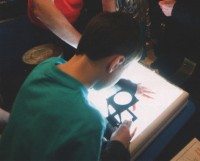
'Hunting the Higgs Boson' is the theme of the Particle Physics For Scottish Schools (PP4SS) exhibition at this year's Edinburgh International Science Festival. Honorary Fellow and PP4SS director Alan Walker will represent the School at the event in the Discover Science Zone in the National Museum of Scotland.
PP4SS aims to support physics teachers by introducing particle physics to school pupils, encouraging them to become engaged with the subject.
'Hunting the Higgs Boson' runs from 13-22 April at 10am-5pm each day.
Image gallery
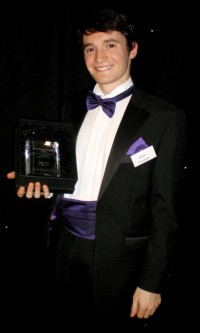
Physics wins for innovative teaching and best postgraduate tutor.
Two members of the Physics teaching team have been recognised in the 2011 EUSA Teaching Awards. The Vitae Award for Best Postgraduate Who Tutors went to Robert Concannon. Two other Physics postgraduates - Adam Apostoli and Kate Slaughter - were also nominated. For Adam, this was the third time in a row.
Simon Bates - who was a runner-up in the two previous years - picked up the Teach First Innovative Teaching Award.
This is the third year that EUSA has made the awards. A record 5,168 student nominations were received for 777 teachers, with 11 awards presented to outstanding members of University staff and postgraduate tutors.
Here are just a few of the comments left by students making nominations.
Simon Bates: award for Innovative Teaching
"Professor Bates puts a lot of energy into his lectures and interacts with the students extremely well... His use of clicker questions keeps his lectures interesting and fun, and allows the students to engage with the lecture content... One of the main aspects of why I think Simon was a good teacher is the fact that every week he would take the time to make screencasts for webCT. These would range from overall advice with studies to specific problems with the subject. This became very helpful as it was able to cover a lot of problems that couldn't be answered in lectures... This interaction outside lectures shows students that Professor Bates has a genuine interest in us all doing well in this course."
Robert Concannon: Best Postgraduate Who Tutors
"He has most definitely given me a deeper understanding of the course material... Rob has always been enthusiastic and incredibly encouraging even when I have been despairing that I would never understand and be able to get through the course material and problems set... He makes maths funny and the tutorials so much more enjoyable. He also readily gave up more of his time if you needed more help... He is brilliant at spotting where you are struggling with a question and diligently makes sure you actually understand everything... I honestly feel that without all his support, patience and determination I would not have managed to pass the course... I was so lucky to have him as a tutor."
Image gallery
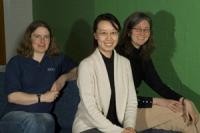
The MSc in HPC Virtual Open Days are live, online interactive sessions where you will meet course staff in chat rooms and virtual spaces. You do not need to attend the University campus, as these events are hosted online.
The next MSc in HPC Virtual Open Days are on:
- Monday 28 March 14:00–15:00 BST
- Wednesday 6 April 11:00–12:00 BST
To book your place, please email your name and the session you would like to attend to: msc [at] epcc.ed.ac.uk.
Image gallery
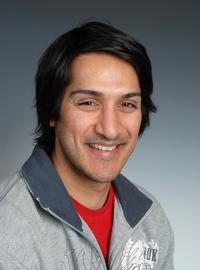
Dr Chamkaur Ghag, a postdoctoral research assistant in the School's Nuclear Physics Group, has been invited to give the Cleveland Institution of Engineers' public lecture in March. Dr Ghag will discuss 'The Search for Dark Matter at Boulby Mine'.
The Cleveland Institution of Engineers was founded in 1864 by a small group of engineering pioneers from the local steel and railway industries. It is the oldest institution of its kind in the world.
The talk will take place on Tuesday 15th March at 5:30pm in the Stephenson Building, Teesside University. See the Cleveland Institution of Engineers' website for more information.
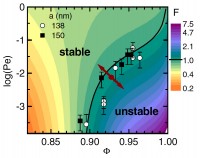
ICMCS researchers ended 2010 with a bang with two papers in Physical Review Letters' last issue of 2010 (week ending 31st December):
- Bartłomiej Waclaw, Rosalind Allen and Martin Evan’s theoretical study of the effect of migration on biological evolution (article number 268101),
- Rut Besseling, Lucio Isa (now in Zürich), Mike Cates and Wilson Poon’s combined experimental and theoretical study of the origins of inhomogeneous shearing (or ‘shear banding’) in concentrated colloidal suspensions (article number 268301) with collaborators in Crete.
This was followed in the first issue of 2011 (week ending 7th January) by a paper from Laurence Wilson (now in Harvard), Vincent Martinez, Jana Schwarz-Linek, Jullien Tailleur, Peter Pusey and Wilson Poon with an Australian sabbatical visitor announcing a new method for the high throughput characterization of the motility of E. coli, yielding the swimming speed distribution and information about the non-motile population in a matter of minutes (article number 018301).
ICMCS is clearly in the process of turning PRL into their house journal: Davide Marenduzzo and Mike Cates have another paper on liquid crystal blue phases in the press: watch this space!
Image gallery
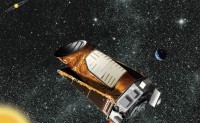
Astronomers from the University of Edinburgh are joining their counterparts in Queen’s University Belfast, Geneva, Harvard, St Andrews and INAF-TNG in the hunt for extra-solar planets similar to the Earth. Together they will build and use a new instrument called HARPS-N for the Italian 3.5-metre Telescopio Nazionale Galileo in the Canary Islands. The instrument will be able to analyse the light of candidates identified from NASA’s Kepler space probe.
Since its launch in March 2009, Kepler has been continually taking images of a single area of sky in the constellation of Cygnus. Of the hundreds of thousands of stars visible in these images, around 1200 show indications of having planetary systems.
Kepler looks for tiny tell-tale dimmings in the light of stars that occur when orbiting planets pass in front of them. However, to be able to understand what kind of worlds these planets are, the light has to be subjected to more detailed examination with the HARPS-N instrument.
HARPS-N will not directly "see" planets. The Kepler planets are far too faint to be seen with any telescope. Instead HARPS looks at their stars and measures the tiny effect the accompanying planets have on their motion. The less massive the planet, the tinier the effect it produces on the star, and the more precise the instrument needed to detect it.
HARPS is able to detect movements at velocities of just a metre per second — the speed of a person walking — in a star hundreds of light-years away. This has allowed planets only a few times more massive than the Earth to be discovered.
The HARPS-N instrument in combination with an analysis of the Kepler data will allow the nature of many of the planets to be understood. Theorists predict that a broad spectrum of different kinds of planet are possible - ranging from solid iron planets through to “solid” water planets - with an Earth-like planet somewhere in between.
“Kepler and HARPS-N offer our first hope of finding planets like the Earth that are at distances from their sun that would allow water to exist as a liquid and - potentially - for life as we know it to evolve,” said Dr Ken Rice of the University's Institute for Astronomy.
HARPS-N project
The HARPS-N project was officially launched in December 2010, with the signing of an international agreement by INAF (Italian National Institute for Astrophysics). HARPS-N will be installed on TNG (Telescopio Nazionale Galileo), the 3.6 meters INAF telescope hosted by the Roque de Los Muchachos observatory, in the Canary Islands.
The HARPS-N project is coordinated by an international consortium led by the Astronomical Observatory of the University of Geneva and comprising: the National Institute for Astrophysics (Italy); the Harvard Smithsonian Astrophysical Observatory, the Harvard College Observatory and the Harvard University Origins of Life Initiative (USA); University of St Andrews; University of Edinburgh, and Queen’s University Belfast (UK).
The project partners are granted 80 observing nights per year to use HARPS-N coupled to the TNG. HARPS-N is currently under construction in Geneva and Edinburgh. Full operating status is scheduled for April 1st, 2012.
The HARPS-N spectrograph (High Accuracy Radial velocity Planet Searcher-North) is being built at Geneva Observatory and the UK Astronomy Technology Centre in Edinburgh. It will operate in the Canary Islands from spring 2012, and will be the northern counterpart of HARPS in the Chilean Andes: currently the most powerful exoplanet hunter in the world.
Image gallery

The International LOFAR Telescope - a network of radio telescopes across Europe - has taken its first ‘pictures’, revealing a black hole in a distant galaxy in greater detail than ever before. The image of the black hole, called quasar 3C196, also demonstrates the huge field of view that LOFAR captures in a single image: an area of sky equivalent to a thousand full moons.
LOFAR’s network of radio telescopes is designed to study the sky at unprecedented resolution, using the lowest radio frequencies accessible from the surface of the Earth. The UK LOFAR station, located at STFC's Chilbolton Observatory, is the western-most telescope in the network, and its addition creates a total array almost 1000 km wide, making LOFAR the largest telescope in the world. The addition of Chilbolton also makes LOFAR's images three times sharper.
Dr Philip Best, a Reader at the University’s Institute for Astronomy, is Deputy LOFAR-UK leader. He said: “LOFAR allows us to see smaller and fainter objects in the sky, which will help us to answer fundamental questions about cosmology and astrophysics, such as when did the first galaxies form. Here in Edinburgh we are very excited about using LOFAR to study galaxies and quasars in the early Universe."
The new image was created by combining signals from LOFAR radio telescopes in the Netherlands, France, Germany and the UK, using the LOFAR BlueGene/P supercomputer in the Netherlands. The connection between the Chilbolton
telescope and the supercomputer requires an internet speed of 10 gigabits per second – over 1000 faster than the typical home broadband speeds.
Professor Rob Fender, LOFAR-UK Leader from the University of Southampton, said "Getting that connection working without a hitch was a great feat requiring close collaboration between STFC, industry, universities around the country and our international colleagues.”
LOFAR was designed and built by ASTRON in the Netherlands and is currently being extended across Europe. As well as deep cosmology, LOFAR will be used to monitor the Sun’s activity, study planets, and understand more about lightning and geomagnetic storms. LOFAR will also contribute to UK and European preparations for the planned global next generation radio telescope, the Square Kilometre Array (SKA).
Further information
LOFAR
LOFAR will focus on six areas of research:
- 1.The Epoch of Reionisation - understanding how the first stars and black holes made the universe hot.
- 2.Extragalactic surveys - what is the history of star formation and black hole growth over cosmological time?
- 3.Transients and Pulsars - probing the extreme astrophysical environments that lead to transient bright bursts in the radio sky.
- 4.Cosmic rays - what is the origin of the most energetic particles in the universe?
- 5.Solar and space environment - mapping the structure of the solar wind, how it relates to solar bursts, and how it interacts with the Earth.
- 6.Cosmic Magnetism - what is the origin of the large-scale magnetic fields that pervade the universe?
LOFAR-UK
The LOFAR station in the UK is the first major new radio telescope to be built in Britain for many decades and was opened by Professor Jocelyn Bell-Burnell on the 20th September 2010. Like all the other stations, it is linked back to a central supercomputing facility at Groningen in the Netherlands using a high-speed network connection, the equivalent of 5000 standard domestic broadband connections combined into one.
LOFAR-UK is funded through a collaboration of UK universities with the SEPnet consortium and the UK Science and Technologies Facilities Council which includes RAL Space at STFC's Rutherford Appleton Laboratory, STFC's UK Astronomy Technology Centre and STFC's Chilbolton Observatory.The LOFAR-UK consortium represents 22 British universities, making it the largest radio astronomy consortium in the country.
The quasar galaxy 3C 196
3C 196 is a quasar (compact radio source) in a galaxy so far away that light from it has travelled for almost half the age of the universe to reach us (at a redshift of z=0.871). The word “quasar” means “quasi-stellar object”. Quasars look like single stars in visible light because the light coming from close to the central black hole is so bright that it outshines all the stars in the galaxy in which it is embedded. The quasar 3C 196 was picked for the first light image of the LOFAR Telescope to show the massive increase in image sharpness (resolution) when the international stations are added to LOFAR.
Image gallery
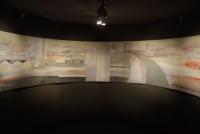
School Acoustic Group collaborates on art installation at Informatics Forum.
Working with Glasgow artist Marianne Greated, the School of Physics and Astronomy has constructed an installation in the Inspace exhibition room in Edinburgh.
The work relates to the theme of anthropogenic sound in our environment, and comprises a hemi-anechoic chamber containing a 10 metre panorama with soundscape in 5.1 surround sound. It is part of the public engagement
programme 'Sound in a Man-Made Environment', which is run by researchers at the University of Edinburgh in partnership with the National Physical Laboratory, and funded at the University by the Engineering and Physical Sciences Research Council.
"The paintings in the panorama depict our urban landscape and the soundscapes have evolved from recordings of those same environments, mainly sourced in and around Glasgow. Levels of anthropogenic sound in our environment have increased significantly in recent years and have an important impact on our everyday lives." Marianne Greated
From January-March 2011 the thematic for Inspace is Non-Bio Boom and this period will feature exhibits and functions relating to the theme of anthropogenic sound.

